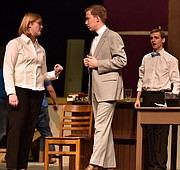Every day we ask ourselves the basic question of right versus wrong, whether it be through our thoughts or our actions. A clear example of that was made in Thomas A. Edison's production of “Inherit the Wind.”
“Inherit the Wind” takes place in the small southern town of Hillsboro, U.S.A., where creationism is the only accepted way of thinking. However, once schoolteacher Bertram Cates brings up Darwin in a lesson, he is put on trial for teaching the forbidden subject of evolution. During the trial, two lawyers, Matthew Harrison Brady and Henry Drummond, fight it out on the compelling issue of creationism versus evolution. Written by Jerome Lawrence and Robert Edwin Lee, “Inherit the Wind” premiered on Broadway in 1955, followed by two revivals in 1996 and 2007.
Edison High School's 32-person cast captured the audience's attention with their reactions and energy, especially during the courtroom scenes. From little tasks such as excessive fanning to mighty worshipping, the ensemble easily transported the audience back to a southern summertime "not too long ago."
Nicholas Riehle convincingly portrayed the wise, aged lawyer Henry Drummond. His strong choices matched those of Thai Duong's Matthew Harrison Brady. Together they created tensions in and out of the courtroom that helped create the picture of best-friend-turned-rivals. Emily Wilson gave an exceptional performance as Rachel Brown. Her character was torn between loyalty towards her controlling reverend father and her colleague and love interest, Cates. Wilson conveyed that conflict well through her emotions and actions. David Leavitt's portrayal of Rev. Jeremiah Brown was one filled thoroughly with passion for his religion.
The townspeople of Hillsboro played off of each other's energy to create the mob mentality evident in this time period. Each member of the ensemble made a clear objective from the very beginning of the show. Their characters, from a Judge to an innocent little schoolboy, brought to life a picture of what a close-knit town is really like.
Although the set and props were simple, they served their purpose. The signs the townspeople waved while marching added to the passion executed by the ensemble. The transition music during the scene changes also helped set the stage for a small southern town, while the stage crew made quick, quiet transitions. Despite some clothing not being of this time period, the audience could make out which character was which with help from the costumes.
Thomas A. Edison's production of “Inherit the Wind” reminded the audience of an important life lesson: the freedom to think is not only for us but for those around us as well.
